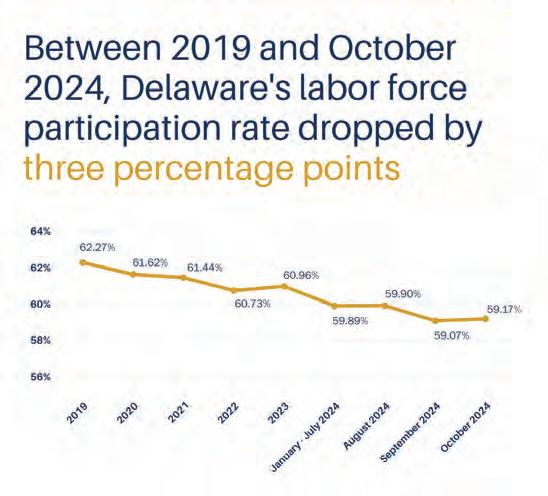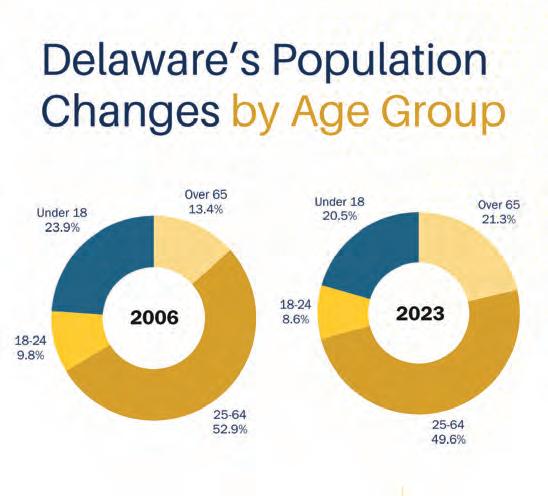
3 minute read
The Trends Shaping Delaware's Future
REVIEWING DEMOGRAPHIC AND LABOR FORCE SHIFTS THAT WILL IMPACT DELAWARE’S ECONOMIC GROWTH OPPORTUNITIES
Delaware is undergoing a transformative period, with demographic shifts, labor force changes, economic challenges, and new opportunities shaping its trajectory. This white paper provides a comprehensive analysis of key trends affecting the state, utilizing a PESTLE framework (Political, Economic, Societal, Technological, Legal, and Environmental) to guide strategic planning.
DEMOGRAPHICS & WORKFORCE SHIFTS
Delaware’s population has grown by nearly 21% since 2006, largely driven by an aging demographic. The population of residents aged 65 and older has surged by 92%, while growth among prime working-age individuals has been modest. Fertility rates remain below replacement levels, reflecting a nationwide trend, and labor force participation has declined from 62.3% in 2019 to 59.2% in late 2024.

While the state benefits from positive domestic and international migration, workforce challenges persist. The number of older workers has doubled in the past two decades, yet early retirements and declining participation rates present long-term concerns. Delaware must address talent shortages and enhance workforce retention to sustain economic growth.
ECONOMIC COMPETITIVENESS & BUSINESS CLIMATE
Delaware’s economy has expanded but at a slower rate than many states. Employment grew just 0.6% from 2023 to 2024—one of the lowest rates nationwide. Future projections indicate a 6.6% job increase by 2034, with healthcare, finance, and transportation sectors leading growth. However, key challenges include:
• Labor Force and Skills Gap: The state’s talent pipeline must align with industry needs, requiring investment in education and workforce development.
• Cost of Doing Business: Delaware ranks 44th in business costs, with high corporate tax rates and rising operational expenses impacting competitiveness.

HOUSING, MIGRATION & AFFORDABILITY
Housing affordability has become a critical concern, with home prices increasing by 56.2% in the past four years. Despite stable homeownership rates, rising costs may deter workforce attraction. Delaware must balance supply and demand through regulatory adjustments to ensure long-term affordability.
TECHNOLOGY & INNOVATION
The rise of Artificial Intelligence (AI) and automation will significantly impact Delaware’s workforce. Key industries, including finance, healthcare, and retail, must adapt to evolving technologies while ensuring workforce preparedness.
Additionally, the state’s innovation ranking (35th) suggests a need for stronger research, development, and entrepreneurial support.
Delaware has the lowest labor force participation rate among its neighboring states.
STRATEGIC PRIORITIES FOR GROWTH
To maintain economic strength and competitiveness, Delaware’s leaders must prioritize:
• Workforce Development: Expanding training programs, attracting skilled workers, and retaining graduates
• Business Climate Improvements: Streamlining regulations, enhancing tax policies, and improving infrastructure
• Housing & Affordability: Addressing housing shortages and cost-of-living concerns
• Technology & Innovation Investment: Supporting AI adoption and fostering a robust startup ecosystem
• Public-Private Collaboration: Strengthening partnerships to drive economic development
By addressing these challenges and leveraging emerging opportunities, Delaware can position itself as a leader in economic growth and quality of life for residents and businesses alike.
Researched and written by Ted Abernathy of Economic Leadership.
To view the full white paper, please scan this QR code:











